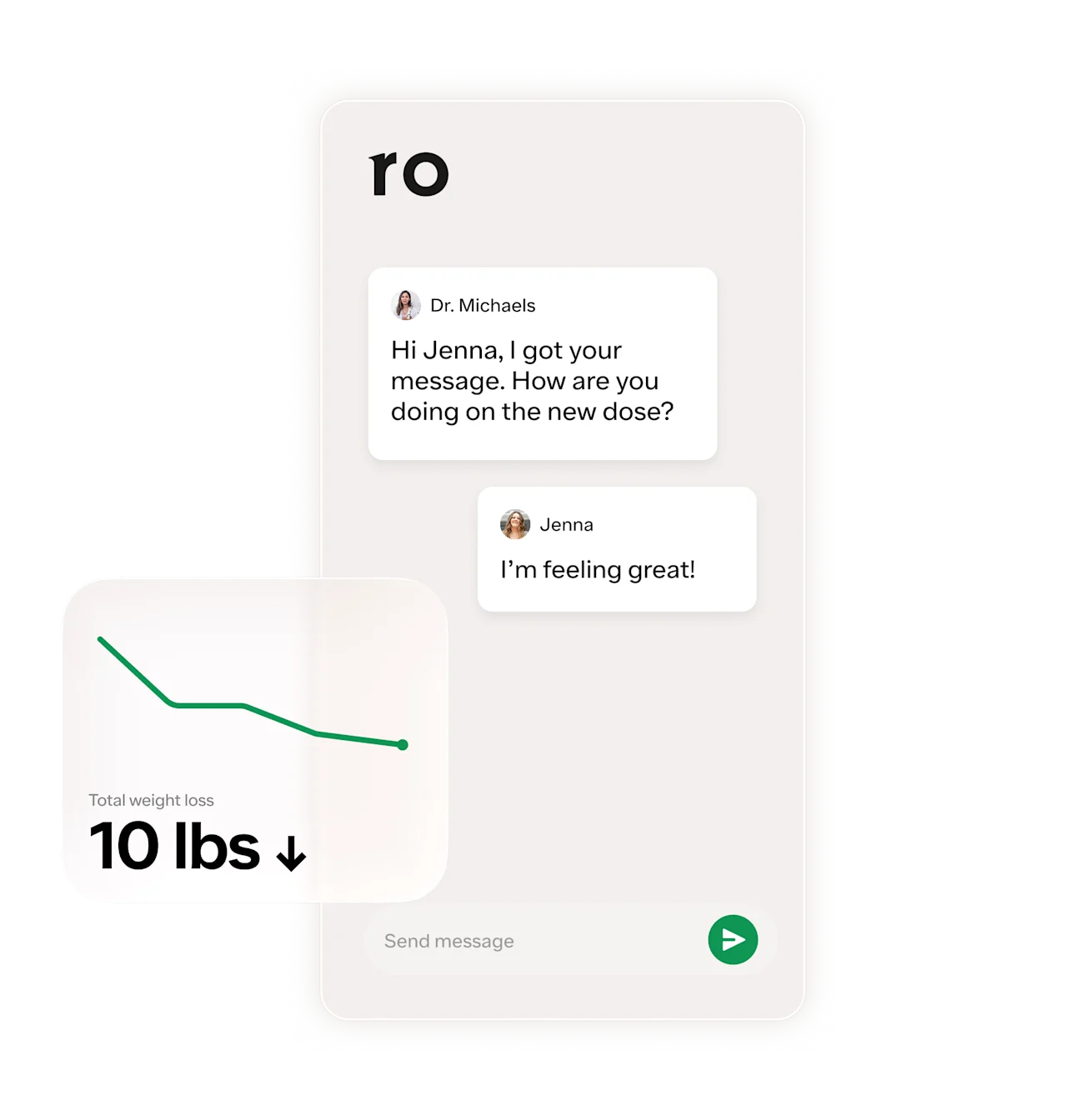Key takeaways
Oral Wegovy (semaglutide) may be FDA-approved by the end of 2025, making it the first oral GLP-1 medication for weight loss.
Clinical trials show that the Wegovy pill can lead to an average 13.6% weight loss in 64 weeks, which is comparable (although slightly less) than the injectable version.
If approved, oral Wegovy would be taken daily instead of weekly like injections.
Here's what we'll cover
Here's what we'll cover
Here's what we'll cover
Key takeaways
Oral Wegovy (semaglutide) may be FDA-approved by the end of 2025, making it the first oral GLP-1 medication for weight loss.
Clinical trials show that the Wegovy pill can lead to an average 13.6% weight loss in 64 weeks, which is comparable (although slightly less) than the injectable version.
If approved, oral Wegovy would be taken daily instead of weekly like injections.
If a fear of needles has kept you from taking Wegovy (semaglutide), we have good news. Oral Wegovy may be available soon — as early as next year, in fact.
The US Food and Drug Administration (FDA) is on track to approve a Wegovy pill by the end of 2025, based on promising clinical trials that showed a similar weight loss to the Wegovy injection.
Read on as we break down the latest news about oral Wegovy, including how it works for weight loss, possible side effects, and how much it might cost you out-of-pocket.
Is Wegovy available as a pill?
As of publication, Wegovy is not (yet) available as a pill. But it may hit the market soon — as early as 2026.
In May 2025, Novo Nordisk, the maker of Wegovy, applied for FDA approval of an oral version of Wegovy.
The manufacturer did this after completing a 64-week OASIS 4 phase 3 randomized controlled trial involving 307 adults with obesity. In the study, participants lost 13.6% of their body weight after taking 25 mg of oral Wegovy daily.
Now, the FDA is expected to decide before the end of the year. Meaning, the Wegovy pill could be available as early as the beginning of 2026.
If approved, this would make Wegovy the first oral GLP-1 explicitly approved for weight loss — but not the first oral GLP-1 overall. That honor belongs to Rybelsus, which is also manufactured by Novo Nordisk.
Rybelsus contains the same active ingredient as the Wegovy pill: semaglutide. Rybelsus is approved to control blood sugar levels in people with type 2 diabetes and to reduce the risk of serious cardiovascular problems in people with type 2 diabetes.
Currently, brand-name Wegovy is available as a weekly injection. It’s approved for weight loss, fatty liver disease, and to lower cardiovascular risk in adults with obesity or overweight and heart disease.
It’s also worth noting that the Wegovy pill isn’t the only oral GLP-1 that may soon be FDA-approved for weight loss and diabetes.
Novo Nordisk’s competitor, Eli Lilly, is also busy working on a GLP-1 pill called orforglipron.
In a 40-week trial, participants with type 2 diabetes who took orforglipron daily lost 5%–8% of their body weight, or about 10–16 pounds.
In another trial, participants with obesity who took orforglipron lost an average of 9%–15% of their body weight after 36 weeks.
The possibility of an oral Wegovy (and, frankly, orforglipron) that’s equally as or close to as effective as injectable GLP-1s is exciting. This is largely because “pills are easier to take,” says Kevin Gendreau, MD, a board-certified obesity medicine physician.
“I’ve had many patients who dislike needles be hesitant to take these life-saving GLP-1 medications,” Dr. Gendreau says. “Pills have a broader acceptance and appeal in my opinion.”
Indeed, surveys show that when given the option, most people prefer an oral GLP-1 over an injection.
How does oral Wegovy work?
Oral Wegovy contains the same active ingredient as injectable Wegovy, semaglutide. So, it works in the same way: by mimicking GLP-1, a naturally occurring hormone that regulates appetite and satiety (fullness).
Here’s how semaglutide — and oral Wegovy — works:
It binds to GLP-1 receptors throughout your GI tract and brain.
It sends satiety (fullness) signals to your brain, which reduces appetite.
It slows gastric emptying (how quickly food leaves your stomach), which makes you feel full sooner.
It balances your blood sugar levels by boosting insulin production and limiting glucagon.
Thanks to these effects, people tend to eat fewer calories and lose weight on Wegovy. In the case of the Wegovy pill, people taking 25 mg daily experienced an average weight loss of 13.6% over a year and three months.
Of course, individual weight loss results can vary. They depend on factors such as other medications in your regimen, diet, and exercise routine.
Rybelsus, the oral form of semaglutide approved for type 2 diabetes, should be taken in the morning on an empty stomach, at least 30 minutes before any food, water, or other medications.
“The same recommendation will likely hold for an oral Wegovy,” says Shannon Fitzgerald, PharmD, a pharmacist, toxicologist, and expert contributor at Drugwatch.com. “This could potentially cause problems for patients taking other medications first thing in the morning on an empty stomach, such as levothyroxine (for the treatment of hypothyroidism).”
How well does oral Wegovy work? What the science says
According to clinical trials, oral Wegovy can produce an average weight loss of 13.6% in 64 weeks (about a year and three months). If you weigh 250 pounds, that’s a loss of 34 pounds.
By comparison, people taking a placebo lost only 2.2% of their starting body weight.
Other clinical trials found that a higher dose of oral Wegovy (50 mg daily) produced even more weight loss — up to 15.1% in 68 weeks.
Another clinical trial found that 50 mg of oral Wegovy reduced people’s caloric intake by nearly 40% in 20 weeks, leading to an average weight loss of 9.8%.
At this time, however, Novo Nordisk is only seeking approval for up to a 25-mg dose of oral Wegovy. This is likely due to the higher rate of gastrointestinal side effects seen with 50 mg, which affected about 80% of participants.
Does oral Wegovy work as well as injections?
While oral Wegovy can produce similar weight loss results to injectable Wegovy, the existing research suggests the injections still work slightly better.
In clinical trials of oral Wegovy, people taking 25 mg daily lost an average of 13.6% of their body weight in 64 weeks. People taking 50 mg daily lost an average of 15.1% in 68 weeks.
In clinical trials of Wegovy injections, people taking 2.4 mg weekly lost an average of 14.9% of their body weight in 68 weeks.
So, people may lose slightly more weight on injectable Wegovy compared to 25 mg of oral Wegovy (aka the hopefully-soon-to-be-approved pill).
But if a 50-mg daily dose is prescribed (which will likely be an off-label dosage), people may actually lose more weight on oral Wegovy vs. injections.
The lower weight loss of the Wegovy pill could be due to its bioavailability (or how much of a drug’s active ingredient gets absorbed by your bloodstream), Dr. Gendreau explains.
“Digestive breakdown in the gut might reduce effectiveness [of a Wegovy pill], requiring higher doses to reach similar efficacy as an injection,” he says.
That may explain why the Wegovy pill that’s currently waiting for FDA approval is 25 mg while the Wegovy injection is only 2.4 mg.
Even so, the Wegovy pill seems to drive enough weight loss to be a viable alternative to GLP-1 injections, according to Dr. Gendreau.
Current research suggests that injectable Wegovy slightly outperforms oral Wegovy. Still, there are other injectable GLP-1s that outperform any form of semaglutide.
Zepbound (tirzepatide) and Mounjaro (tirzepatide), for example, produce an average weight loss of 15%–20.9% in about the same time, according to a 72-week trial for obesity.
Side effects of oral Wegovy
Oral Wegovy seems to have similar side effects and risks as other semaglutide medications, mostly affecting the gastrointestinal (GI) system.
Based on phase 3 trials of the 25-mg Wegovy pill, the frequency of GI side effects was similar to what was seen in trials of Wegovy 2.4 mg weekly injections. These include:
Nausea
Diarrhea
Vomiting
Constipation
Stomach pain
Headache
Fatigue
Upset stomach
Dizziness
Bloating
Belching
Flatulence
Hypoglycemia (low blood sugar) in people taking certain diabetes drugs
Stomach flu
Heartburn
Common cold
One possible benefit of a Wegovy pill is avoiding injection site reactions such as pain, rash, or irritation, Dr. Fitzgerald adds. However, these only affect a small number of people taking injectable Wegovy.
How much will oral Wegovy cost?
We won’t know for sure how much oral Wegovy costs until the FDA approves it and Novo Nordisk announces a price. But it’s possible that it could cost less than injections — if it’s less expensive to make.
“[Oral Wegovy] should be more competitively priced due to the fact that it’s easier to make (no pens) and easier to store and distribute (no refrigeration),” Dr. Gendreau says.
On the other hand, Dr. Fitzgerald points out that Novo Nordisk currently prices the diabetes medications Ozempic (injectable semaglutide) and Rybelsus (oral semaglutide) similarly, with both hovering around $1,000 per month.
Moreover, the 25 mg Wegovy pill contains more than ten times the amount of semaglutide than the 2.4 mg maximum dose of injectable Wegovy. That may also drive costs up, according to Dr. Fitzgerald.
When will oral Wegovy be approved?
Oral Wegovy may be approved by the FDA by the end of 2025. Meaning, it could be available for prescriptions starting in early 2026.
According to a press release from Novo Nordisk, the maker of oral Wegovy, the company submitted its application to the FDA in spring 2025. The FDA is expected to decide on approval sometime in Q4 of 2025.
Bottom line
For people who’ve avoided GLP-1 injections due to a fear of needles, oral Wegovy could be a game-changer. If approved, it will be the first oral GLP-1 medication specifically for weight loss.
The FDA is set to approve oral Wegovy by the end of 2025, so prescriptions may be available in early 2026.
A 25 mg daily Wegovy pill produced an average 13.6% weight loss in clinical trials, which is close to the 14.9% seen with 2.4 mg weekly injections.
Side effects of oral Wegovy in studies are similar to the mild-to-moderate gastrointestinal side effects common with the injectable version.
Pricing hasn’t been announced, but experts expect it to be similar or cheaper than injectable Wegovy.
DISCLAIMER
If you have any medical questions or concerns, please talk to your healthcare provider. The articles on Health Guide are underpinned by peer-reviewed research and information drawn from medical societies and governmental agencies. However, they are not a substitute for professional medical advice, diagnosis, or treatment.
Wegovy Important Safety Information: Read more about serious warnings and safety info.
GLP-1 Important Safety Information: Read more about serious warnings and safety info.
Zepbound Important Safety Information: Read more about serious warnings and safety info.
Mounjaro Important Safety Information: Read more about serious warnings and safety info.
Ozempic Important Safety Information: Read more about serious warnings and safety info.
References
Aroda, V. R., Aberle, J., Bardtrum, L., et al. (2023). Efficacy and safety of once-daily oral semaglutide 25 mg and 50 mg compared with 14 mg in adults with type 2 diabetes (PIONEER PLUS): a multicentre, randomised, phase 3b trial. Lancet (London, England), 402(10403), 693–704. doi: 10.1016/S0140-6736(23)01127-3. Retrieved from https://pubmed.ncbi.nlm.nih.gov/37385279/
Chubb, B., Gupta, P., Gupta, J., et al. (2021). Once-Daily Oral Semaglutide Versus Injectable GLP-1 RAs in People with Type 2 Diabetes Inadequately Controlled on Basal Insulin: Systematic Review and Network Meta-analysis. Diabetes Therapy, 12(5), 1325–1339. doi: 10.1007/s13300-021-01034-w. Retrieved from https://link.springer.com/article/10.1007/s13300-021-01034-w
Igarashi, A., Hansen, B. B., Langer, J., et al. (2020). Preference for Oral and Injectable GLP-1 RA Therapy Profiles in Japanese Patients with Type 2 Diabetes: A Discrete Choice Experiment. Advances in Therapy, 38(1), 721–738. doi: 10.1007/s12325-020-01561-1. Retrieved from https://link.springer.com/article/10.1007/s12325-020-01561-1
Jastreboff, A. M., Aronne, L. J., Ahmad, N. N., et al. (2022). Tirzepatide Once Weekly for the Treatment of Obesity. The New England Journal of Medicine, 387(3), 205–216. doi: 10.1056/NEJMoa2206038. Retrieved from https://pubmed.ncbi.nlm.nih.gov/35658024/
Gabe, M. B. N., Breitschaft, A., Knop, F. K., et al. (2024). Effect of oral semaglutide on energy intake, appetite, control of eating and gastric emptying in adults living with obesity: A randomized controlled trial. Diabetes, Obesity & Metabolism, 26(10), 4480–4489. doi: 10.1111/dom.15802. Retrieved from https://dom-pubs.pericles-prod.literatumonline.com/doi/10.1111/dom.15802
Knop, F. K., Aroda, V. R., do Vale, R. D., et al. (2023). Oral semaglutide 50 mg taken once per day in adults with overweight or obesity (OASIS 1): a randomised, double-blind, placebo-controlled, phase 3 trial. Lancet (London, England), 402(10403), 705–719. doi: 10.1016/S0140-6736(23)01185-6. Retrieved from https://pubmed.ncbi.nlm.nih.gov/37385278/
Kommu, S. & Whitfield, P. (2024). Semaglutide. StatPearls. Retrieved from https://www.ncbi.nlm.nih.gov/books/NBK603723/
McGuire, D. K., Marx, N., Mulvagh, S. L., et al. (2025). Oral semaglutide and cardiovascular outcomes in High-Risk Type 2 diabetes. New England Journal of Medicine, 392(20), 2001–2012. doi: 10.1056/nejmoa2501006. Retrieved from https://www.nejm.org/doi/full/10.1056/NEJMoa2501006
Novo Nordisk. (2025). Press Release: FDA accepts filing application for oral semaglutide 25 mg, which if approved, would be the first oral GLP-1 treatment for obesity. Retrieved from https://www.novonordisk-us.com/media/news-archive/news-details.html?id=915988
Rosenstock, J., Hsia, S., Nevarez Ruiz, L., et al. (2025). Orforglipron, an oral small-molecule GLP-1 receptor agonist, in early type 2 diabetes. The New England Journal of Medicine, 393(11), 1065–1076.doi: 10.1056/NEJMoa2505669. Retrieved from https://www.nejm.org/doi/10.1056/NEJMoa2505669
Shubrook, J. H., Radin, M., Ali, S. N., et al. (2022). Preference for Type 2 diabetes therapies in the United States: A Discrete choice experiment. Advances in Therapy, 39(9), 4114–4130. doi: 10.1007/s12325-022-02181-7. Retrieved from https://link.springer.com/article/10.1007/s12325-022-02181-7
U.S. Food and Drug Administration (FDA-a). (2025). Highlights of Prescribing Information: Rybelsus (semaglutide) tablet, for oral use. Retrieved from https://www.accessdata.fda.gov/drugsatfda_docs/label/2025/213051s024,s028s029lbl.pdf
U.S. Food and Drug Administration (FDA-b). (2025). Highlights of Prescribing Information: Wegovy (semaglutide) injection, for subcutaneous use. Retrieved from https://www.accessdata.fda.gov/drugsatfda_docs/label/2025/215256s024lbl.pdf
Wharton, S., Blevins, T., Connery, L., et al. (2023). Daily Oral GLP-1 Receptor Agonist Orforglipron for Adults with Obesity. The New England Journal of Medicine, 389(10), 877–888. doi: 10.1056/NEJMoa2302392. Retrieved from https://www.nejm.org/doi/10.1056/NEJMoa2302392
Wharton, S., Lingvay, I., Bogdanski, P., et al. (2025). Oral Semaglutide at a Dose of 25 mg in Adults with Overweight or Obesity. The New England Journal of Medicine, 393(11), 1077–1087. doi: 10.1056/NEJMoa2500969. Retrieved from https://pubmed.ncbi.nlm.nih.gov/40934115/
Wilding, J. P., Batterham, R. L., Calanna, S., et al. (2021). Once-Weekly Semaglutide in Adults with Overweight or Obesity. New England Journal of Medicine, 384(11), 989–1002. doi: 10.1056/nejmoa2032183. Retrieved from https://www.nejm.org/doi/10.1056/NEJMoa2032183














